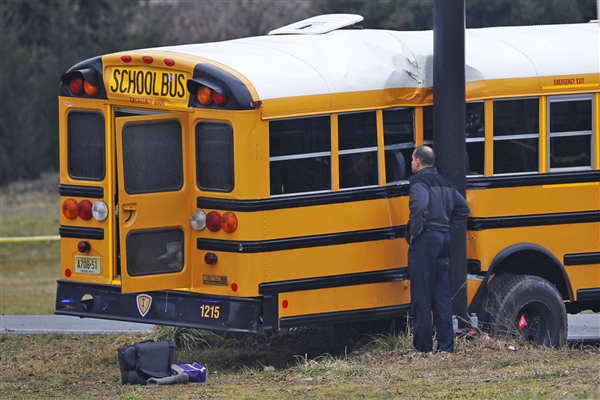FYI…
NTSB calls for wireless technology to let all vehicles 'talk' to each other

Matt Rourk / AP file
An investigator views the scene of a school bus crash on Feb. 16, 2012, near Chesterfield, N.J.
By M. Alex Johnson, Staff Writer, NBC News
Federal safety authorities Tuesday called for all U.S. cars, trucks and buses to come equipped
with technology that would allow them to "talk" to one another to help avoid accidents.
The proposal was one of three the National Transportation Safety Board made Tuesday in its
investigation of two school bus accidents last year. The main focus was an
accident near Chesterfield, N.J., that killed an 11-year-old girl, but the board also looked at evidence from a similar accident in Port St. Lucie, Fla., that also killed a student. In both accidents,
the school buses collided with trucks at intersections.
In
a summary report (.pdf), the board recommended that the National Highway Traffic Safety Administration develop standards for "connected-vehicle technology" — wireless components that would let vehicles communicate on the road. The full final report
is expected in about three weeks.
With those standards in place, "NHTSA can then require this technology to be installed on
all highway vehicles," Deborah Hersman, chairman of the NTSB, said at the board's meeting Tuesday. "This technology more than anything else holds great promise to protect lives and prevent injuries."
Related:
Are connected cars dangerous or a safety feature?
The Alliance of Automobile Manufacturers, the trade group for most of the major automakers
— which is working with the NHTSA on research and development of connected-vehicle technology — didn't immediately respond to a request for comment.
But in testimony before the Senate Transportation Committee in May, Mitch Bainwol, the alliance's
president and chief executive, raised doubts that such systems could be feasible in the near term.
Aftermarket component systems would need to be overhauled, a patchwork of state and federal
laws would have to be unified and legal questions of liability surrounding operating cars with automated systems would have to be hashed out, he said.
"The question of who is responsible — when (and) for what — will need to be addressed," Bainwol
said.
Last August, the NHTSA began conducting a yearlong study of 3,000 connected vehicles in Ann
Arbor, Mich., using WiFi-like components that send electronic data messages back and forth and translate the data into a hazard warnings for the drivers. The test is focusing on safety at intersections, lane changes and rear-end accidents involving vehicles
stopped at intersections.
"Vehicle-to-vehicle communication has the potential to be the ultimate game-changer in roadway
safety — but we need to understand how to apply the technology in an effective way in the real world," NHTSA Administrator David Strickland said when the test was launched.
Regarding the two school bus crashes, the NTSB also recommended tougher qualifications for
agencies that oversee the medical certification of commercial drivers. The summary report found that the driver of the bus in the New Jersey crash was fatigued and was using sedatives, and it said he likely wouldn't have been issued a license had he disclosed
all the medications he was taking.
In an animated reconstruction of the New Jersey crash, NTSB investigators depicted the truck's
speeding into the intersection just as the school bus was leaving it. The reconstruction shows the truck ramming into the left rear side of the bus, which spins off the road.
The truck driver was speeding and was carrying an overweight load in a truck that had defective
brakes, the NTSB said.
And the NTSB also looked at the effectiveness of the seat belts on the bus in New Jersey —
one of only six states that require school buses to have them.
The board said seat belts and shoulder belts would have helped to reduce flailing injuries,
but it stopped short of recommending their mandatory use nationwide.
Instead, it recommended that school districts offer training to bus drivers, students and
parents to drive home "the importance of wearing seat belts" in the states that do require them: California, Florida, Louisiana, New Jersey, New York and Texas.
The National Association for Pupil Transportation said it was eager to work with the NTSB
and the NHTSA "to evaluate the practicability of implementing the recommendations that have been offered today."
Rich Kennedy
Standards Manager
![]()
mobile: +1 (972) 207-3554
office: +1 (972) 910-3448
If you wish to be removed from this reflector, do not send your request to this reflector - it will have no effect.
Instead, go to http://listserv.ieee.org/cgi-bin/wa?SUBED1=STDS-802-11-REG and then press the LEAVE button.
Further information can be found at: http://www.ieee802.org/11/Email_Subscribe.html _______________________________________________________________________________